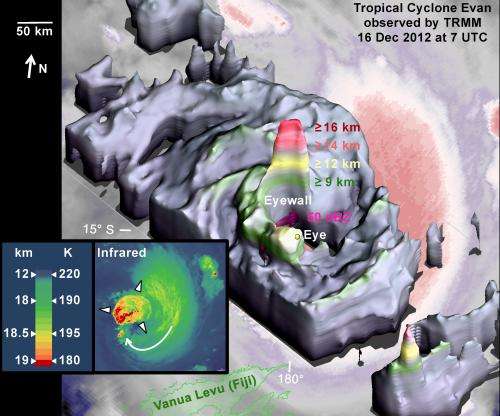NASA satellite finds an unusually tall storm-cell in Cyclone Evan

NASA's Tropical Rainfall Measuring Mission or TRMM satellite found an unusually tall towering thunderstorm in Cyclone Evan.
According to Owen Kelley of the TRMM satellite team at NASA's Goddard Space Flight Center in Greenbelt, Md, the most startling feature of the December 16 overflight of Tropical Cyclone Evan was the extremely tall storm-cell in the north side of the eyewall. At the time TRMM passed overhead and captured an image of the storm, Evan was about to rake across the northern coast of the islands of Fiji.
The updrafts in this tower extended high enough to lift precipitation-size ice 17 km (10.5 miles) above the ocean surface. Tall precipitation cells are generally taken to be anything at least 14.5 km (9 miles) high and are nicknamed "hot towers," but what was seen in Evan's eyewall was a different category of storm cell.
Storm-cells as tall as the one in the eyewall of Evan have been long known to occur occasionally over land, but before the TRMM satellite, there were not thought to occur over ocean far from land. While field campaigns have periodically studied one location or other over the ocean, what TRMM has taught us is that such sporadic observations are insufficient if you want catch rare events. After 15 years of continuous operation, TRMM satellite reveals the rare features and challenges our understanding of how the weather works. The ocean is an unlikely place to find extremely tall oceanic cells because the ocean surface stays roughly constant in temperature, unlike the land which quickly heats up over the course of a day, increasing low-level instability, and encouraging tall cells to form.
During the first 10 years of the TRMM mission, only 5 thunderstorm cells as tall as the one seen in cyclone Evan were observed in South Pacific tropical cyclones. Due to their rarity, perhaps these 17-km-tall (10.5 mile) cells deserve their own nickname. To distinguish them from run-of-the-mill hot towers, one can call these cells "titans," "super towers," or just extremely tall.
Over all of the tropical oceans, only 174 such extremely tall cells were observed during the first 10 years of TRMM (1). That's 174 extremely tall cells out of the approximately 9 million oceanic storms that TRMM saw during that time. It is worth noting however, that even TRMM has its limitations. It does not observe the whole earth continuously and frequently misses short-lived events. With this in mind, these extremely tall cells most likely occur more often than TRMM observes them although they do make up a very small fraction of the ocean's weather.
TRMM also observed cloud top temperatures. At the north side of the eyewall, was the upper-level outflow from the extremely tall tower, i.e. the tower's "exhaust fumes." The exhaust moves outward horizontally in every direction, including toward the eye at the center of the tropical cyclone. It is through a process called "forced subsidence" that the exhaust from eyewall towers may warm the air in the tropical cyclone's eye. Warming the air in the eye lowers the surface pressure and encourages intensification of the winds circling the eye.
The TRMM satellite is a joint mission between the United States and Japan.
Provided by NASA's Goddard Space Flight Center




















